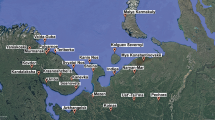Abstract
Applied problems of the analysis of data series of flood-forming storm precipitation (rain intensity over short time intervals), containing several events per year are discussed. The use of data containing several events per year has been shown to be justified for reliable determination of statistical characteristics of time series at a short observation period. The statistics of time series containing one or more events per year have been shown to correlate well with the frequency of the observed phenomenon in the Ural region. Recommendations have been developed for recalculating the statistics of the series containing several events per year into statistics for a single event per year; a brief comparative analysis of the methods used in Russia in this field is given.



Similar content being viewed by others
REFERENCES
Alekseev, G.A., Evaluating the probability of hydrological and climatological events, which occur several times a year, Tr. Gl. Geofiz. Obs. im. A.I. Voeikova, 1954, vol. 43, no. 97, pp. 106–112.
Gumbel, E., Statistics of Extremes, Columbia Univ. Press.: New York, 1962.
Johnson, N.L., Kotz, S., and Balarkishnan, N., Odnomernye nepreryvnye raspredeleniya (Continuous Univariate Distributions), Part 2., Teoriya veroyatnostnykh raspredelenii (Theory of Probability Distributions), Moscow: BINOM, 2010.
Kartvelishvili, N.A., Stokhasticheskaya gidrologiya (Stochastic Hydrology), Leningrad: Gidrometeoizdat, 1975.
Klimenko, D.E., Eponchintseva, D.N., Korepanov, E.P., and Cherepanova, E.S., Studying the reduction curves of flood-forming storm precipitation in Transuralia, Meteorol. Gidrol., 2018, no. 2, pp. 76–89.
Kritskii, S.N. and Menkel’, M.F., Gidrologicheskie osnovy upravleniya rechnym stokom (Hydrological Principles of River Runoff Control), Moscow: Nauka, 1981.
Mezhdunarodnoe rukovodstvo po metodam rascheta osnovnykh gidrologicheskikh kharakteristik (International Guide on the Methods for Calculating Main Hydrological Characteristics), Leningrad: Gidrometeoizdat, 1984.
Ratkovich, D.Ya. and Bolgov, M.V., Stokhasticheskie modeli kolebanii sostavlyayushchikh vodnogo balansa rechnogo basseina (Stochastic Models of Variations of Water Balance Components in a River Basin), Moscow: Inst. Vod. Probl., Ross. Akad. Nauk, 1997.
Rukovodstvo po gidrologicheskoi praktike. Sbor i obrabotka dannykh, analiz, prognozirovanie i drugie primeneniya (Guide on Hydrological Practice. Data Collection and Processing, Analysis, Forecasting, and Other Applications), World Meteorological Organization, WMO-168, 1994. 1997.
Hald, A., Statistical Theory with Engineering Applications, New York–London, 1952.
Khristoforov, A.V., Kruglova, G.V., and Samborskii, T.V., Stokhasticheskaya model’ kolebanii rechnogo stoka v pavodochnyi period (A Stochastic Model of River Runoff Variations during Floods), Moscow: Mosk. Gos. Univ., 1998.
Chebotarev, A.I. and Serpik, B.I., Choice and substantiation of formulas for calculating maximal discharges of rain floods, in Sb. rabot po gidrologii (Coll. Works in Hydrology), Leningrad: Gidrometeoizdat, 1973, issue 11, pp. 3–47.
Comprehensive Risk Assessment for Natural Hazards, World Meteorological Organization. WMO/TD-No. 955. 1999.
Estimation of Maximum Floods, World Meteorological Organization, WMO-No. 233, TP 126, Techn. Note No. 98, Geneva, 1969.
Hershfield, D.M., Method for estimating probable maximum rainfall, J. American Waterworks Association, vol. 57, August, 1965, pp. 965–972.
Hershfield, D.M., Rainfall frequency atlas of the United States for durations from 30 minutes to 24-hours and return periods from 2 to 100 years, Techn. Paper 40, Washington, DC: US Weather Bureau, 1961, pp. 400–440.
Intercomparison of models of snowmelt runoff. Operational Hydrology Report № 23. WMO Publ. № 646. Geneva: World Meteorological Office, 1986. 440 p.
Manual for Depth–Area–Duration Analysis of Storm Precipitation, World Meteorological Organization. WMO-No. 237, Geneva, 1969.
Manual for Estimation of Probable Maximum Precipitation, World Meteorological Organization, Operational Hydrology Re. No.1, WMO-No. 332, Geneva, 1986.
Miller, J.F., Physiographically Adjusted Precipitation–Frequency Maps: Distribution of Precipitation in Mountainous Areas, WMO, no. 326 (11), 1972, pp. 264–277.
Pilgrim, D.M. and Cordery, I., Flood runoff, Handbook of Hydrology, New York, USA: McGraw-Hill, 1993.
Pilgrim, D.M. and Cordery, I., Rainfall temporal patterns for design floods, ASCE J. Hydraulic Engineering, 101 (HY1), 1975, pp. 81–95.
Pilgrim, D.H. and Doran, D.G., Practical criteria for the choice of method for estimating extreme design floods, IAHS. Publ. no. 213, Wallingford, UK: Inst. Hydrology, 1993.
Pilgrim, D.H., Australian Rainfall and Runoff. A Guide to Flood Estimation, Canberra: Inst. Engineers Australia, 1998.
Sevruk, B. and Geiger, H., Selection of Distribution Types for Extremes of Precipitation, World Meteorological Organization. Operational hydrology rep. no. 15. WMO-No. 560, Geneva, 1981.
Todorovic, P. and Woolhiser, D.A., Stochastic structure of the local pattern of precipitation, Stoch. Approach to Wat. Res., 1976, vol. 2, pp. 217–222.
Todorovic, P. and Yevfevich, V., Stochastic processes of precipitations, Colorado State Univ. Hydro. Paper, 1969, vol. 35, pp. 1–61.
Author information
Authors and Affiliations
Corresponding author
Additional information
Translated by G. Krichevets
Rights and permissions
About this article
Cite this article
Klimenko, D.E., Cherepanova, E.S. & Kuz’minykh, A.Y. Evaluating Parameters of the Distributions of Extreme Storms with Several Events per Year Taken into Account. Water Resour 46, 630–637 (2019). https://doi.org/10.1134/S0097807819040110
Received:
Revised:
Accepted:
Published:
Issue Date:
DOI: https://doi.org/10.1134/S0097807819040110




